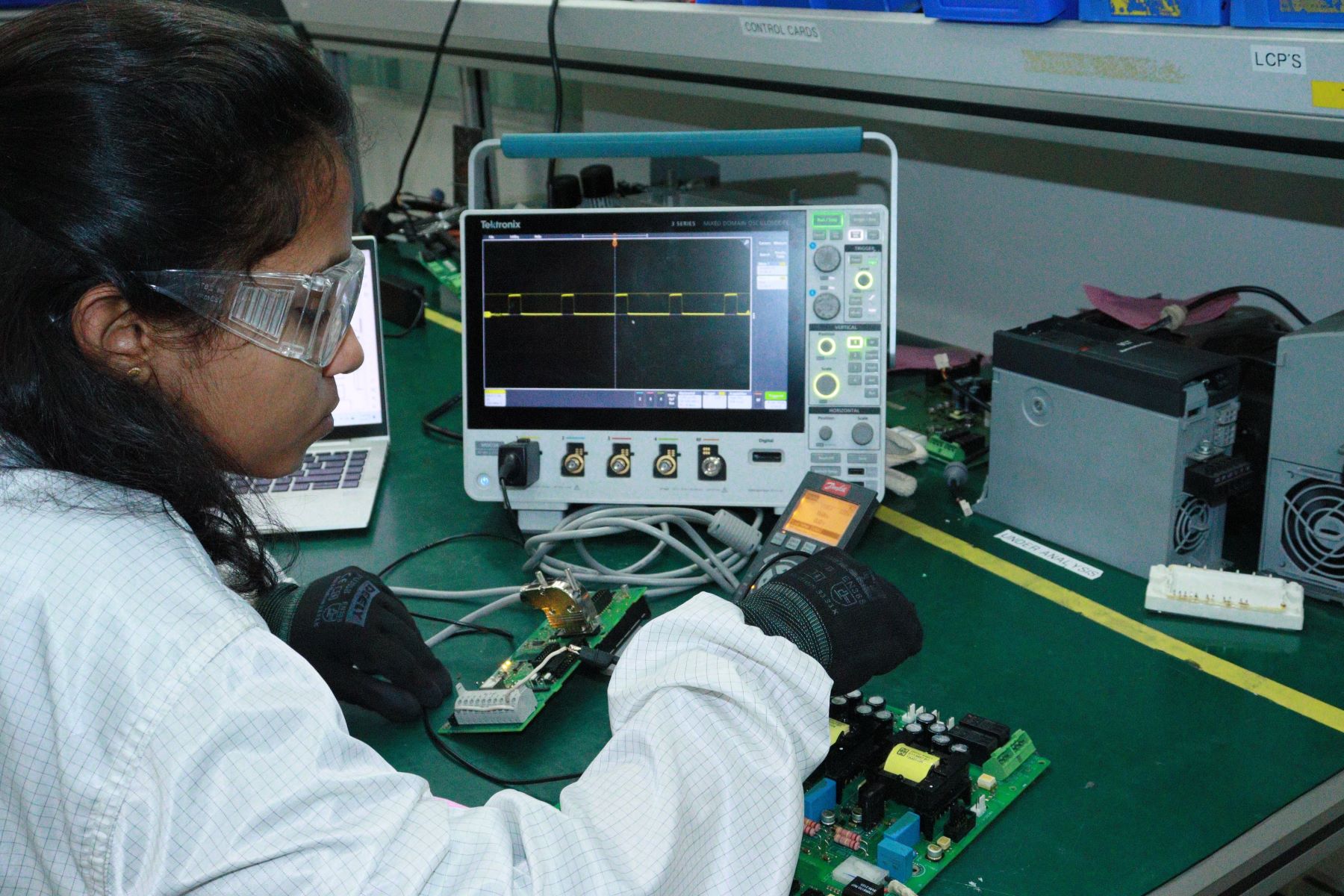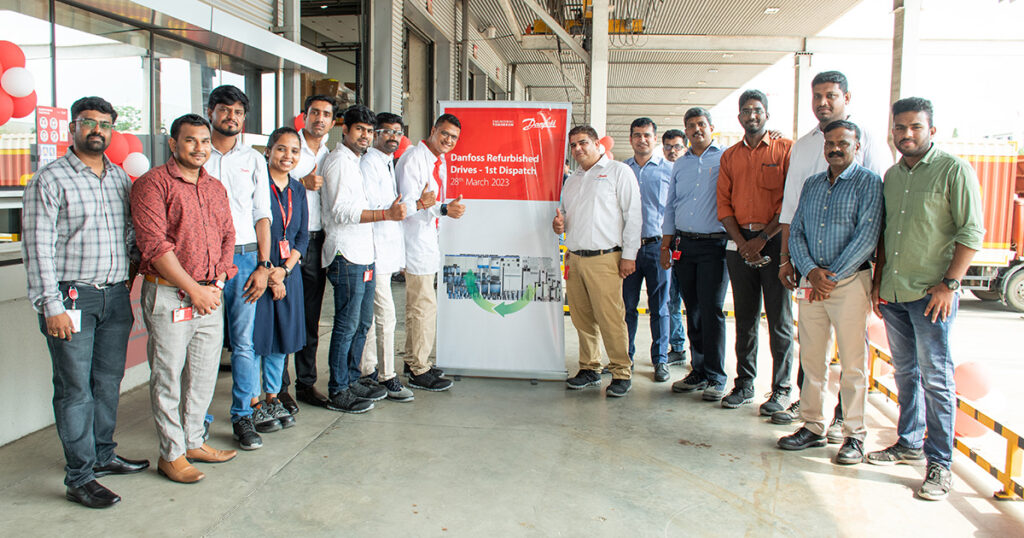The world is generating an exponentially increasing volume of electronic waste. One solution is to repair and resell products. And in this regard, Danfoss reports great success of a pilot project conducted in a corner of a factory in India. Taking the pilot to scale, however, is still a tough nut to crack.
 Refurbishment hos Danfoss
Refurbishment hos DanfossWe’re in India, in one of Danfoss’ vast manufacturing halls, where a small 100-150 m2 corner has been dedicated to a green experiment: repair and testing of frequency transformers.
According to WHO, e-waste is the fastest growing solid waste stream globally, with the average citizen worldwide discarding an average of seven kilos of used electronic devices annually. India ranks third on the list of countries generating the most electronic waste, and more than 90 per cent of the nation’s waste ends up in informal waste streams, where illegal scrap merchants earn money from rare metals in the electronics. Although this means that some metals are recycled, the process is not regulated, and the result is environmental pollution, huge landfills and health hazards for those extracting the metals.
So there are compelling reasons to try to bring fractions of the mounting volume of e-waste back into the manufacturing loop, especially if the products are still functioning.
Fully functioning products should not go in the grinder
‘At Danfoss we take back products that fail while still under guarantee in order to learn about the fault so it can be avoided in future. We then replace the faulty component to verify that this was the culprit, and having done so, suddenly have a functioning piece of industrial equipment on our hands. The question is: What to do with it?’ says Ingvard Jensen, Vice President of Global Business Engineering, Danfoss, who adds:
It just seems plain wrong to stuff recently repaired, fully functioning equipment into a waste grinder.
Ingvard Jensen, Vice President of Global Business Engineering, Danfoss
Yet this was previously standard practice, mainly because of a tacit understanding, as Jensen puts it, ’that no business would be looking to buy them’.
Break the “elephant” up into chunks
In a MADE research project, Danfoss has been assisted in pinpointing this return-flow of faulty products as an opportunity for trialling a take-back programme, meaning a system where the manufacturer accepts product returns for repair/reuse. Steffen Foldager, PhD from Aalborg University, assisted Danfoss in devising the programme currently being piloted in India.
‘Everything was a first, which was a big challenge: How do we take the products back, where are they located, and what condition are they in? How do we get them out on the market again? We needed a known platform where we wouldn’t be at square one, so we modelled the pilot on the pre-existing Danfoss returns flow. This enabled us to break the elephant up into smaller chunks,’ Foldager explains.
According to Jensen, in the MADE PhD project this facilitated ‘discussions about where to start, and the goals and means.’ Ultimately, it led to a pilot project to resell used frequency transformers in India, not least because ‘the price of hardware is crucial in a country like India,’ Jensen explains.
The market’s there
That said, the upshot of the take-back pilot so far has been a welcome surprise. A separate test setup was created for the repaired products so they don’t disrupt the ordinary production line and to prevent any mix-up of new and repaired products. The last being crucial, as the repaired products are sold at a different price.
‘We sell the used products at a discount because we want to push them to the market, and happily, there is a market for them. We’re now selling them to three partners who resell the products,’ says Aneesh Koyadan Choikunnel, senior manager, Danfoss, who headed up the pilot in India.
The frequency transformers are sold without compromising on brand quality, as the repaired transformers are required to pass the same tests as new ones.
The first of the repaired products were offered for sale in the first half of 2023, and the pilot is due to close out in 2024.
A shift in mindset
Take-back is not usually good business because it costs money to process returned products, to disassemble and repair them, and to set up a sales organisation at the other end. Although the taking back and repairing are not added expenses for Danfoss in the pilot, this type of programme is still ‘not a revenue source for the company,’ according to Jensen. But commitment to the concept has still grown within and outside Danfoss:
‘The focus used to be more on reliability than sustainability, and there was a lack of confidence that used goods could have a long lifespan,’ says Jensen, who adds:
‘We’re seeing a change in mindset among quite a few customers now, and for our part have also started prioritising sustainability and reuse higher relatively to other parameters such as profit. The market is ready now.’
This is confirmed by a customer survey conducted for Danfoss by Foldager, in which 82% stated that they were interested in a refurbished resale product.
However, these figures are based on the Danish market. In India, Koyadan Choikunnel put a lot of effort into selling the take-back concept to customers and business partners.
‘We had to account for how it makes sense in terms of CO2, e-waste and so on,’ he explains.
The scaling problem
The challenge right now is not finding customers, but turning out refurbished used products.
‘The biggest challenge is getting enough used units, as we don’t get that many failing while under guarantee. The good news is that we don’t have to hunt for many buyers afterwards,’ says Jensen.
In the pilot setup, the factory takes back 30-60 frequency transformers a month. The resale potential nationwide in India is a mere 50-75 a month, so for this particular product, there’s not much more trade to aim for.
Koyadan Choikunnel, Jensen and Foldager all stress that it is difficult to make a business out of take-back if you scale up with new products and more customers. The type of frequency transformers refurbished in the pilot project for resale have been selected as a noteworthy case owing to the slightly higher number of units involved than for the high-bulk products, and the relative ease of repairing them compared with less bulky products. Nevertheless:
‘There’s no ready-made take-back model for us to copy. It requires a lot of demos, but I’m confident it can be scaled, although that will be a challenge, partly because the products are in short supply, may be relatively old when returned, or are difficult to disassemble,’ Foldager explains.
Jensen adds:
‘My hope is that it pays off in the long run because then it will be worth doing more of the same. This must be possible to achieve. Repairs as opposed to landfills are the only way forward.’
Approvals from the Indian state apparatus
The vision of upscaling the pilot means that Danfoss are aiming to launch take-back in other countries. To achieve that, they will be drawing on all the know-how amassed by Koyadan Choikunnel and his team in the Indian ecosystem, where the country’s mounting e-waste problems have come under intense political scrutiny. Most recently, a new law was enacted in April 2023 to require registration of parties in the manufacturing and waste chain.

One lesson learnt is that plenty of time must be allowed for navigating the complex rules laid down by each federal state.
‘Federal state approvals in India took a lot of time and effort. This varies from one country to the next, but in India, we had to have a large number of approvals concerning how we dispose of products that cannot be repaired, pollution, waste stream management and so forth. It took eight months to gather data and get it all rubber-stamped,’ Koyadan Choikunnel explains.
All in all, the pilot has been a ‘huge learning process’ and ‘tantamount to manufacturing a new product’, he enthuses. He’s not alone.
‘Engagement around the project is running high. It just makes so much sense to not scrap this equipment. Everyone can see it’s the right thing to do,’ says Jensen.
MADE FAST
MADE FAST (Flexible, Agile, and Sustainable production enabled by Talented employees) is a new industrial lead research, innovation, and education partnership to develop the next generation of Danish advanced manufacturing capabilities.
MADE FAST will drive competitiveness by enabling Danish manufacturers to produce customer specific products, scale production from small series production to mass customisation, accelerate, support, scale and improve employee training, and develop sustainable manufacturing operations which reduce the environmental footprint of their manufacturing operations.